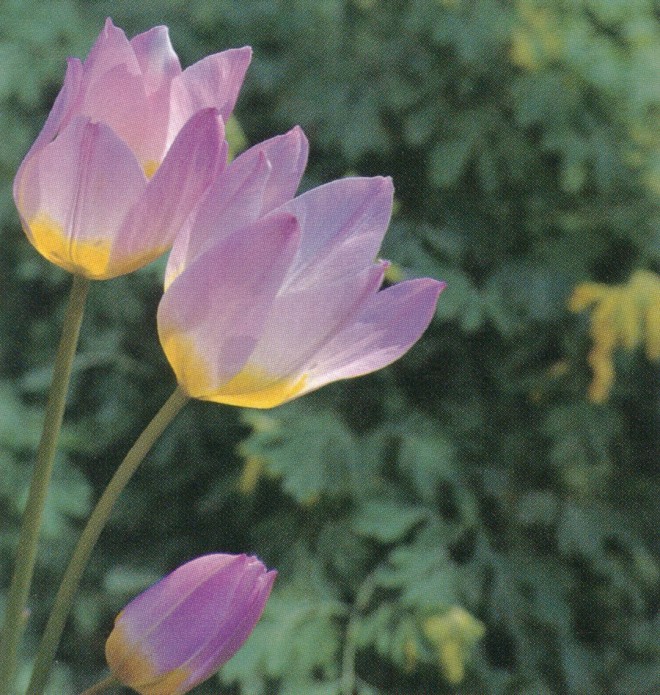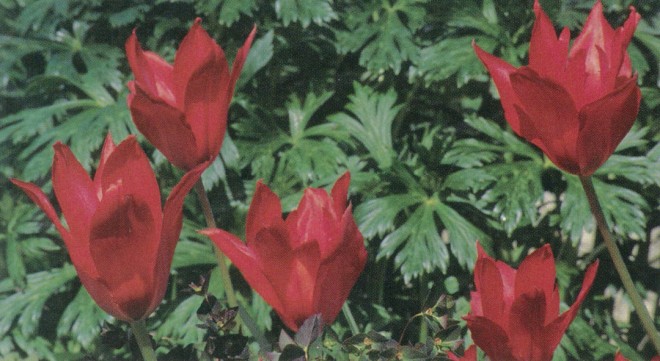
Species Tulips

Contributor
- Topics: Plants You Need

Tulipa hageri reminds me of old tiles, or of the soft orange of Pompeian frescoes. The anthers are a dull plum color when the flower opens, and then they split and turn out a coat of rust-colored pollen. The bright green buds, slowly turning red, and the narrow curled leaves, are a part of the pattern.
Elizabeth Lawrence, The Little Bulbs
I know. I’m a pushover. All it took was that short passage by Elizabeth Lawrence, and I was hooked.
Searching bulb catalogs for Tulipa hageri revealed the selection ‘Splendens’, described as multi-flowering with several “coppery, brick red” flowers per stem. Twenty small bulbs could be had for less than ten dollars, so off went the order, and my adventure with species tulips began.
Describing Tulipa hageri challenges the vocabulary. To me, its tepals are a dull, Chinese lacquer red, a fine complement to the dark gray green of its leaves. In comparison, the usual springtime pinks and yellows seem unimaginative—all too willing to gain attention by their volume rather than the originality of their song.
Tulipa hageri ‘Splendens’ has lived happily in my rock garden for five years. Every year, a few more blossoms join the patch. All they seem to need is what all species tulips most desire: a sunny, dry summer and sharp drainage year round. Elizabeth Lawrence had difficulty growing some species tulips in the summer humidity of North Carolina. But most species tulips hail from around the Mediterranean Sea, the Caucasus Mountains, or Asia Minor, so cold does not faze them, and the dry summers of the West Coast suit them just fine. Happily, well-placed species tulips return year after year, some increasing generously by seed or stolon.
In my Seattle garden, among those dozen or so species that have returned for three to five years, are the long-lived Tulipa batalinii clan, including ‘Apricot Jewel’, ‘Bright Gem’, and ‘Bronze Charm’. From Bukhara (part of present day Uzbekistan in western Asia), T. batalinii seems to be ready for anything. These eager, apricot or soft, bronzy-yellow, urn-shaped blossoms may actually begin to open while sitting on the soil, impatient for their six-inch stems to catch up with their enthusiasm.

A particularly fetching picture in my garden last April was a patch of ‘Bronze Charm’ planted with the standard dwarf bearded iris, ‘Firestorm’. This iris—a yellow plicata richly dotted with burgundy—was a perfect companion for the small, yellow and red bronze flushed tulips.
In my experience, there is little difference among the three named Tulipa batalinii selections. All are delightful and will even flower in ordinary garden soil in partial shade if you ask them to do so.

Another April bloomer from the same part of the world, Tulipa linifolia has small, shiny, lipstick red flowers with a black base and narrow, red-edged leaves. Also only six inches tall, its sprightly hardiness guarantees success in a well-drained location. The scarlet flowers are fine companions for the red-edged, spring growth of Euphorbia x martinii.

Blooming at the same time in April is Tulipa saxatilis (Bakeri Group) ‘Lilac Wonder’ (sometimes sold as T. bakeri ‘Lilac Wonder’). The pristine, lilac pink tepals open wide in full sun, fade to creamy pink, and join in a golden yellow base that supports equally golden anthers. These seven-inch-tall treasures, originally from Crete, star when combined with the soft gray greens of early perennials or grasses.

Another April bloomer, which may blossom even earlier in a warm year, is the taller and slimmer Tulipa clusiana ‘Cynthia’. Named for the early seventeenth century champion of tulips, Charles de l’Ecluse (known as Clusius), T. clusiana is commonly called lady tulip. It reputedly spreads stoloniferously and has the red and white-striped crispness of peppermint candy. ‘Cynthia’ replaces the white with pale cream yellow. There is no more elegant sight than a spreading patch of these long-necked ladies, whimsically popping up wherever their curiosity takes them.

By this time, you might find it difficult to believe that today’s giant Darwin tulips and their kin have, over the centuries, been bred from these sturdy but diminutive charmers. One species, Tulipa vvedenskyi ‘Tangerine Beauty’, looks a bit more like some of the garden hybrids. A vivid, fire-engine red, lightly brushed with orange, the large blossoms of ‘Tangerine Beauty’ stretch their eight-inch necks to reach the sun and invariably stop visitors in their tracks.

Equally irresistible and one of the most determined of the small tulips is Tulipa ‘Little Princess’. I have yet to discover the royalty from which these prolific princesses descend, but their liveliness and charm is evident from the moment the first one takes the stage in early May. Although rarely more than four inches tall, these exotic sisters sport tepals of rich, warm orange with a black base edged in creamy white. And they are fragrant. As if they know how charming they are, they refuse to quit, enjoying the sun every day for several weeks.
Occasionally, it is not the color or behavior of a plant that persuades me to yield to a tempting new purchase, but a name. Smitten by the mellifluous sounding Tulipa orphanidea ‘Flava’, I succumbed early to a dozen tiny bulbs. They have flowered annually—a soft yellow, the tips dipped in red, with the small floral cups hiding a surprising, bronze center. When paired with one of the bronze sedges, their complex coloring is even more enjoyable.

Tulips in the Whittallii Group of Tulipa orphanidea, may be the most spectacular of all the tiny species. A rich, streaky, almost luminescent orange, they brighten even the grayest spring day, and in the sunshine, they glow with color, perfect with the new foliage of Spiraea japonica Magic Carpet and the buds of a soft orange, deciduous azalea.
Like most success, too much of it can lead to carelessness. When I discovered Tulipa humilis var. pulchella ‘Alba Coerulea Oculata’ (a more costly, “award-winning, glistening white rarity with a deep, steel blue base”), I immediately had to own a few of these precious bulbs—especially since they were of “limited supply.” Just learning the name of this remarkable gem was a challenge; finding a spot for it to live proved equally difficult. Of the five bulbs originally planted, admittedly in a less than perfect site, sadly, only three flowered in their second year.
But that won’t keep me from trying again. This time, I will place them in a sunnier spot with grittier soil where they will surely be happy. Their companion? The standard dwarf bearded iris ‘Dark Vader’, a deep blue (almost black), ruffled iris with bushy blue beards. Surely his powers will fend off the elements, and one more patch of species tulips will happily increase.
[sidebar]
A Species Tulip Resource Guide
Mail Order Nurseries:
McLure & Zimmerman
PO Box 368, Friesland, WI 53935-0368
800/883-6998, www.mzbulb.com
Brent and Becky’s Bulbs
7463 Heath Trail, Gloucester, VA 23061
877/661-2852, www.brentandbeckysbulbs.com
Van Engelen Inc
23 Tulip Drive, Bantam, CN 06750-1631
860/567-8734, www.vanengelen.com
[/sidebar]
Share:
Social Media
Garden Futurist Podcast
Most Popular
Videos
Topics
Related Posts

Low Maintenance Gardens – Better for Pollinators and People
Autumn 2022 “I come out every day. It’s therapy, my meditation.” Janet’s young garden transformed from overgrown, invasive plants to mostly natives. The dailiness of

Calochortophilia: A Californian’s Love Affair with a Genus
Summer 2022 I can chart the progression of my life by Calochortus. For the last two decades, at least. As a teenage girl growing up

Pacific Plant People: Carol Bornstein
Spring 2022 Public gardens play a key role in demonstrating naturalistic planting design, selecting native and adapted plants for habitat, and testing techniques for reducing

Add Year-Round Interest and Winter Blooms for Pollinators
Spring 2022 This article was created from an Interview by Merrill Jensen with Neil Bell in the Summer of 2021 for our Pacific Plant People










Responses